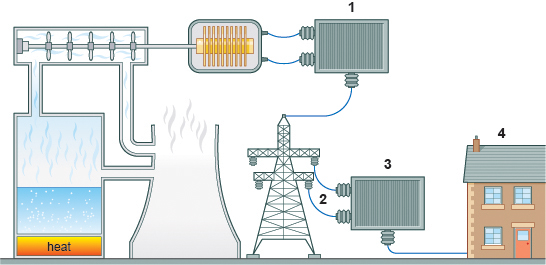Power Stations and the National Grid
The National Grid
⇒ All those pylons and cables that cover the country are collectively known as the national grid
- The national grid consists of a system of transformers and high-voltage cables
- It is only these transformers and cables that are the national grid
⇒ The electricity has to get from the power stations to all the houses around the country
Job of a power station
⇒ The role of a power station is to convert one type of energy (such as that stored in fossil fuels) into electricity

⇒ Energy is convered into electricity in three steps:
- Firstly, the fuel (such as gas or nuclear fuel) is put into a boiler to create steam
- Then, the steam will cause a turbine to rotate
- Finally, the movement creates electromagnetic induction (see notes on The Dynamo Effect) to produce electricity
⇒ One of the big problems with power stations is the amount of energy that is lost through wasted heat and noise
Transformers
⇒ You've all probably got a transformer in your phone charger and in your laptop.
⇒ Out of the wall of your house you get 230 volts out, but that into your phone (for example) will damage it, so we need to change the voltage somehow. We do this using transformers
⇒ There are two different types of transformer: step-up transformer and step-down transformer
- The up and down bit refers to the voltage (or potenial difference)
Step-up transformer
⇒ With the step-up transformer, the potential difference is increased
⇒ As a result, the current is reduced
- Remember power is equal to current x voltage (P = I x V)
- We know from the conservation of energy laws that we have to get the same amount of energy out as we put in. So, if you reduce voltage you have to increase current and vice versa.
Step-down transformer
⇒ With the step-down transformer, the potential difference is decreased
⇒ As a result, the current is increased
Why does the national grid need transformers?

⇒ So, as seen above, the power station creates the electricity
- We can predict how much electricity the UK might need at any one time.
- For instance, we may want to increase the electricity supply when demand is high (e.g. at half time of the world cup final when everyone puts on their kettle) or lower the electricty supply when demand is low (e.g. in the middle of the night when everyone is asleep)
⇒ From the power station we go to the step-up transformer, which increases the potential difference (i.e. voltage) and reduces the current
- If we have a high current flowing through something, that will generate a lot of heat / thermal energy
- In other words, a high current will mean lots of heat produced in the transmission wires on the national grid. So reducing the current means less heat is produced in the transmission wires, and therefore less energy will be dissipated as heat
- Within the transmission cables the voltage will be around 400,000 volts
⇒ When we get to the other side, towards the consumer end, there is a step-down transformer, which will reduce the potential difference (i.e. voltage) and increase the current
- Putting 400,000 volts through your plug socket would not be good, so we need a step-down transformer to make the plugs in your house safe to use
- In your house, the voltage will be around 230 volts